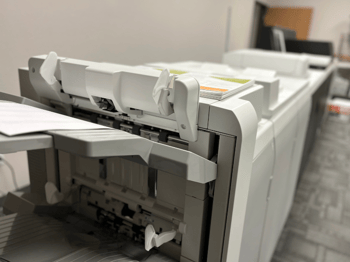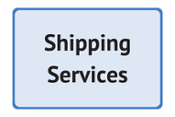If we’ve seen it once, we’ve seen it a hundred times: enthusiastic yet inexperienced marketers running up print fulfillment costs by creating exotic designs that are undeniably beautiful but prohibitively expensive to produce and distribute. And there’s no shortage of printers who are happy to encourage that sort of behavior and take your money in the process.
We hate to see people taken advantage of. That’s why we’re sharing the following seven tips to help you keep your print marketing costs under control
1. Meet with your printer early
If possible, involve your printer early in the development process. Share your budget guidelines or restrictions. Solicit input about size, paper, file formats, production methods such as web to print, proofing requirements, and distribution options. Then listen to what they have to say. It’s best to go into the project with eyes wide open.
 2. Pick the right paper
2. Pick the right paper
Paper, not surprisingly, is the most expensive part of any print job. Therefore, the paper you choose will have a significant impact not only on the finished product, but on the budget as well. Pay attention to the paper your designer specs for the job. Ask the printer whether a less expensive alternative stock could be used instead. Some customers will use the printer’s “house sheets”—that is, paper that is in stock and readily available—to save money. Bottom line: if you can use less expensive paper without compromising the quality of the finished piece, do it.
3. Size matters
The paper typically used for commercially printed marketing material comes in standard finish sizes (multiples of 8-1/2” x 11” in the U.S. and Canada; 8.27” x 11.69”, or A4, in the rest of the world). Odd sizes require extra cutting and often result in significant waste, which will cost you big bucks. Graphic designers (at least good ones) will know and respect this.
4. Carefully consider quantities
If you want to be financially responsible, then carefully consider the print quantity. A number of factors must be taken into account when determining this number. Will the piece be used for a single, time-sensitive purpose? If so, and you know how many you’ll need, then print just enough to cover that amount plus, say, a 3–5% overage as a buffer. This avoids waste and reduces, if not eliminates, the cost of storing excess stock. Conversely, if it’s a piece of print collateral that could potentially be useful for a long period of time, print enough to satisfy anticipated demand over the next several months. Since every print job includes set-up costs, producing large quantities of scale now will save money in the long run by eliminating the need for frequent and expensive reprints.
5. Allow plenty of time
 If your printer doesn’t have time to process your job sufficiently, you’re not only jeopardizing your campaign’s success, you’re also probably going to incur unnecessary rush charges. Not only that, but when a job is rushed, that’s when mistakes tend to sneak in. Be deliberate in the planning stages so you’re not playing catch up down the line.
If your printer doesn’t have time to process your job sufficiently, you’re not only jeopardizing your campaign’s success, you’re also probably going to incur unnecessary rush charges. Not only that, but when a job is rushed, that’s when mistakes tend to sneak in. Be deliberate in the planning stages so you’re not playing catch up down the line.
6. Proofread, proofread, and proofread some more
This should go without saying: it’s a lot easier (and cheaper) to fix mistakes in the development stage than in the printing stage. Therefore, it’s in your best interest to ensure the files you hand off to the printer have been proofed multiple times. Pay particular attention to names, addresses, dates, phone numbers, URLs and e-mail addresses; for some reason, these are often overlooked. If possible, have more than one person proof the text; people who read the same thing over and over tend to start scanning, making it difficult to find particularly elusive errors. Remember: finding and fixing mistakes before the presses roll will save you a lot of money and potential embarrassment. Hire a professional if necessary—you won’t regret it.
7. Mailing it? Plan ahead
If you’re printing something that will be sent through the USPS as part of a broader campaign, work out the shipping details early on. Consult your graphic designer, your printer, and your mailing expert (good commercial printers will have mailing expertise, too). Discuss the size and weight of the piece, the type of stock used, print quantities, the print and distribution schedule, and any other critical dates around delivery. Factor these shipping costs into the overall budget so you know if you need to find more cost-effective alternatives.
We hope these tips and suggestions will help you gain control over your commercial printing and fulfillment costs. Share them with your team and your graphic designer, and let us know if there’s anything else we can do.


